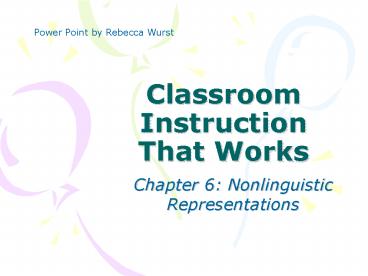Classroom Instruction That Works - PowerPoint PPT Presentation
1 / 18
Title:
Classroom Instruction That Works
Description:
There are a variety of patterns that can be used to make time sequence patterns. ... Characteristic. Characteristic. Characteristic. Example. Example. Example ... – PowerPoint PPT presentation
Number of Views:140
Avg rating:3.0/5.0
Title: Classroom Instruction That Works
1
Classroom Instruction That Works
Power Point by Rebecca Wurst
- Chapter 6 Nonlinguistic Representations
2
Research and Theory
Dual-coding theory of information storage
knowledge is stored in two forms
- LINGUISTIC
- IMAGERY (Nonlinguistic)
- Information stored as words.
- Information stored as pictures, sensations,
movement, etc.
3
The more we use both systems of representation
linguistic and nonlinguistic the better we are
able to think about and recall knowledge. p.73
- Engaging students in the creation of
nonlinguistic representations stimulates and
increases activity in the brain Gerlic
Jausovec, 1999.
4
Two generalizations to guide teachers in the use
of nonlinguistic representations
- There are many ways to produce nonlinguistic
representations in the minds of students. - i.e. creating graphic representations, making
physical models, generating mental pictures, etc.
(pp. 73-74).
- Nonlinguistic representations should elaborate
on, or add to, knowledge.
5
How do we help students generate nonlinguistic
representations?
- One way is to create Graphic Organizers These
use both the linguistic mode and nonlingustic
mode of knowledge acquisition and storage. - Following, are 6 types of graphic organizers.(see
pp.75-80)
6
Descriptive Pattern Organizer
- Used to represent facts about specific persons,
places, things, and events. - Does not need to be in a particular order.
FACT
FACT
TOPIC
FACT
FACT
FACT
7
Time-Sequence Patterns
EVENT
EVENT
EVENT
EVENT
EVENT
- Useful for organizing events in a specific
chronological order. - There are a variety of patterns that can be used
to make time sequence patterns. The figure above
is one such pattern.
8
Process/Cause-Effect Patterns
- With this organizer you can put information into
a causal network leading to a specific outcome
or into a sequence of steps leading to a specific
product (p.76).
EFFECT
9
Episode Patterns
Duration
Place
Time
EPISODE
Cause
Effect
Person
Person
Person
- These organize information about specific events,
including - Setting (time and place) and duration.
- Specific People and Sequence of Events
- A Particular Cause and Effect
10
Generalization/Principle Patterns
- This organizer is useful when forming information
into general statements with supporting examples.
GENERALIZATION PRINCIPLE
Example
Example
Example
11
Concept Patterns
- This is the most general of all of the
organizers. - Shows classes, categories, characteristics or
attributes of persons, places, things and events.
Characteristic
Characteristic
CONCEPT
Example
Example
Characteristic
Example
Example
Example
Example
12
Students can use more than one graphic organizer
with a topic.
- See pp.79 and 80 for one student's use of three
different graphic organizers to help himself
remember information for a test.
13
What are some other ways to help students
generate nonlinguistic representations?
- Making Physical Models
- Generating Mental Pictures
- Drawing Pictures and Pictographs
- Engaging in Kinesthetic Activity
see pp.78-83
14
Making Physical Models
- Concrete representations of knowledge that is
being learned. - This will establish an image in the students'
minds. - Some examples are -
- Using Styrofoam balls to show phases of the moon
(pp. 78-81). - Making math manipulatives.
- Building relief maps with clay.
15
Generating Mental Pictures
- Help students imagine a picture of what is being
learned. - Can be used for -
- Advance organizers. Imagine... (see
pp. 81-82 for an example). - Abstract equations (p.81).
- Understanding a story (p. 72).
16
Drawing Pictures and Pictographs
- Similar to generating mental pictures, students
generate actual drawings or pictographs (drawing
using symbols or symbolic pictures) to help
understand information being taught. - For example -
- Coloring or drawing skeletal system.
- Drawing a representation of the solar system.
17
Engaging in Kinesthetic Activity
- Learning that involves physical movement.
- Examples of how this is used in classrooms -
- Doing Body Math (pp.82-83).
- Using the manual alphabet while teaching new
spelling words.
18
As you can see, there are many ways teachers can
help students create nonlinguistic
representations, so that learning can be enriched
and students can be enlightened.

